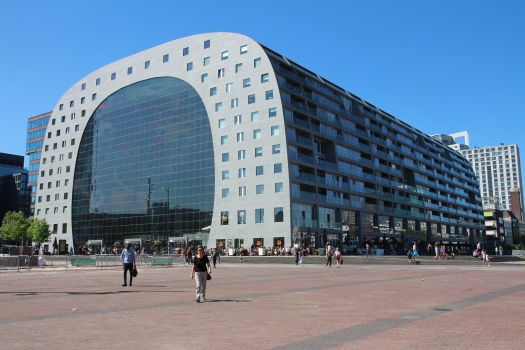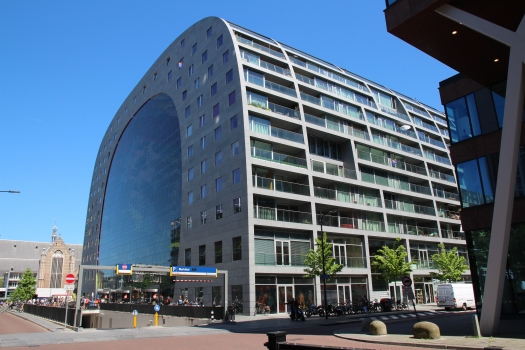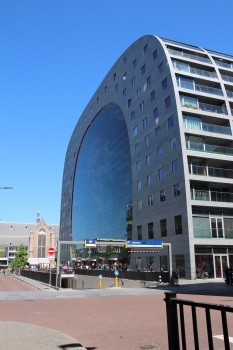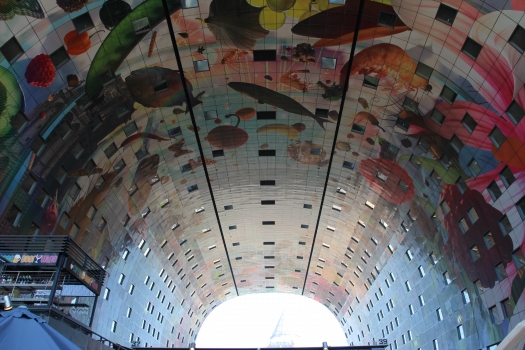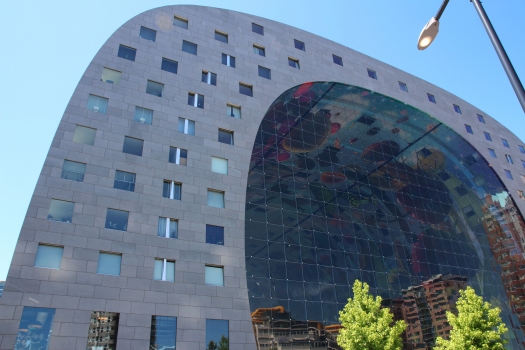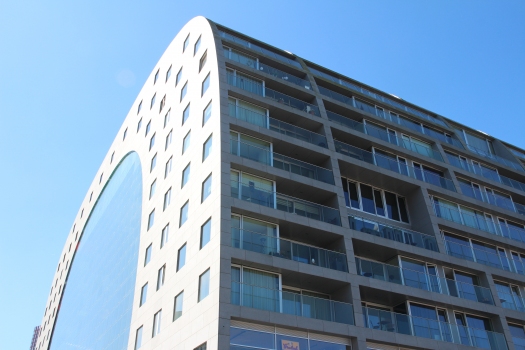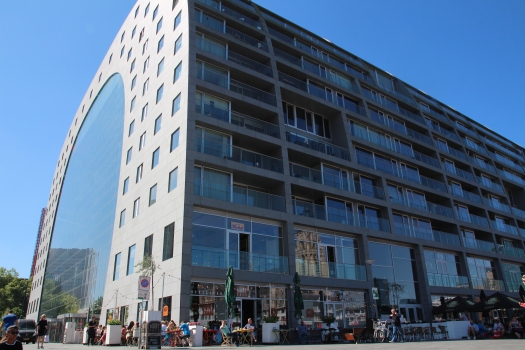General Information
Project Type
| Function / usage: |
Apartment building Office building Market hall |
|---|
Location
| Location: |
Rotterdam, South Holland, Netherlands |
|---|---|
| Coordinates: | 51° 55' 12.28" N 4° 29' 12.47" E |
Technical Information
Dimensions
| height | 40 m | |
| number of floors (above ground) | 11 | |
| number of floors (below ground) | 4 | |
| number of apartments | 228 | |
| number of parking spaces | ca. 1 200 | |
| retail floor space | 4 600 m² |
Cost
| cost of construction | Euro 178 000 000 |
Materials
| cables |
steel
|
|---|---|
| pylons |
steel
|
Excerpt from Wikipedia
The Markthal (English: Market Hall) is a residential and office building with a market hall underneath, located in Rotterdam. The building was opened on October 1, 2014, by Queen Máxima of the Netherlands. Besides the large market hall, the complex houses 228 apartments, 4600 m² retail space, 1600 m² horeca and an underground 4-storey parking garage with a capacity of 1200+ cars.
Architecture
The Markthal was designed by architectural firm MVRDV. The grey nature stone building has an archwise structure like a horseshoe. The building has a glass facade on both sides, these are made up of smaller glass windows. The smaller windows are mostly squared and around 1485 millimeters wide. All of these are hung around a structure of steel cables, 34 metres high and 42 metres wide, which makes it the largest glass-window cable structure in Europe. Each facade has 26 vertical and 22 horizontal cables. The facade was designed and installed by Octatube
Artwork
The inside of the building is adorned with an 11.000 m² artwork by Arno Coenen, named Hoorn des Overvloeds (Horn of Plenty). The artwork shows strongly enlarged fruits, vegetables, seeds, fish, flowers and insects.
The artwork of Coenen was selected out of 9 international candidates. The work was made using digital 3D-techniques. This enormous file of 1,47 terabytes needed special servers, which are also used by Pixar Studios for making animated movies. The digital 3D-animation was separated in 4000 pieces and then printed on perforated aluminum panels. The 4000 aluminum panels are now on the inside of the hall. Right after the opening in 2014, the artwork got a lot of attention from around the world. Some called it The largest artwork in the world or The Sistine Chapel of Rotterdam.
Archaeological site
The Markthal is built on top of a fourteenth-century buried village in the Polder of Westnieuwland. This polder was surrounded by water and dykes to protect the polder during high-tide. There were a few houses and farms in this polder, also at the site of the Markthal.
During the building of the Markthal, a tenth-century farm was found 7 metres under the ground. Within the house were two stoves and a few fireplaces. The farm was part of a village before Rotterdam, named Rotta, after the river Rotte. The inhabitants of Rotta were farmers, craftsmen and traders. Earlier, a small settlement from the fourteenth-century was found on the site.
Several foundations on the site are now exhibited next to the central staircases underneath the Markthal.
Text imported from Wikipedia article "Market Hall (Rotterdam)" and modified on July 23, 2019 according to the CC-BY-SA 4.0 International license.
Participants
Relevant Web Sites
Relevant Publications
- Rotterdamer Architekturpreis für die "Markthal". In: Bauphysik, v. 38, n. 2 (April 2016), pp. 126.
- About this
data sheet - Structure-ID
20073093 - Published on:
04/07/2017 - Last updated on:
06/07/2017

